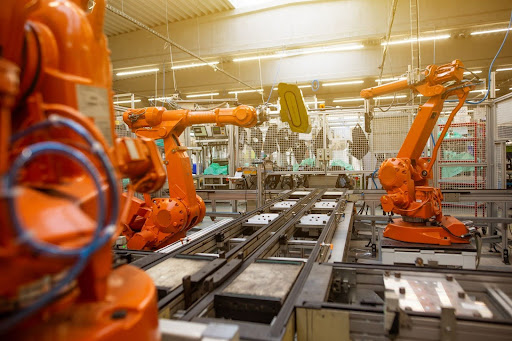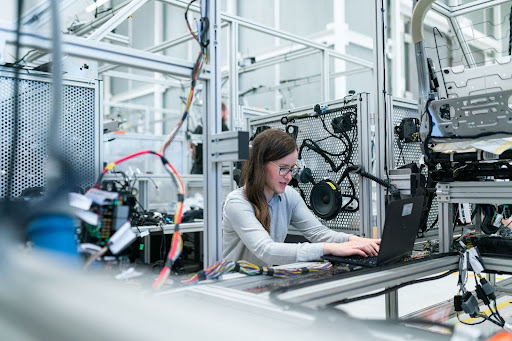
The role of automation and technology in modern plastics manufacturing
Blog
The role of automation and technology in modern plastics manufacturing
Authored By: SDI Plastics
The plastics manufacturing industry has undergone immense change and innovation over the past several decades, driven by rising global demand for plastic products across virtually every sector. According to Statista, the global production of thermoplastics was estimated to be 370 million metric tons in 2021. This figure is projected to increase to 445.25 million metric tons in 2025 and 590 million metric tons by 2050. With increased production has come increased automation, allowing manufacturers to boost efficiency, lower overall costs, and respond faster to shifts in market demand.
At its core, plastics production involves converting various petrochemical-based polymers, resins, and additives into finished plastic parts and products. This is achieved through diverse processing methods including injection moulding, blow moulding, thermoforming, 3D printing, and more. The type of technique used depends greatly on the end product application. For instance, plastic packaging relies heavily upon extrusion and blow moulding using polyethylene and polypropylene resins, while medical device components leverage precision injection moulding.
Automating various steps in the production workflow – from materials handling, to moulding, finishing steps, and quality assurance – allows manufacturers to minimise overall processing times and labour requirements while maximising repeatability, precision, overall capacity and throughput. Modern plastic manufacturing plants feature an array of automated systems working in orchestration, including industrial robots, cobots, self-correcting process control software, infrared sensors to monitor product quality assurance, and automated packaging systems.
Beyond the production floor, analytics and artificial intelligence are being embraced to synthesise vast amounts of machine and production data. Identifying inefficiencies allows process refinement for reduced scrap and downtime. Predictive maintenance circumvents equipment failures and keeps overall uptime high. Manufacturers are also utilising technology to enable quicker design iteration and time-to-market for new products demanded by customers.While automation technologies require considerable upfront investment, over the longer term they allow plastic product manufacturers to greatly bolster profit margins through substantially lower unit costs. In addition, automated systems enhance overall agility and the capability to quickly scale production as market conditions dictate. This has proven invaluable amid recent global supply chain disruptions.
The modern Plastics Manufacturing landscape
The plastics manufacturing sector in Australia is a major economic contributor, generating annual revenues of over $25 billion. It comprises around 1,300 businesses that, together, employ over 60,000 people nationwide. Production is concentrated in Victoria, New South Wales, and Queensland.
Globally, around 370 million metric tonnes of plastic were produced in 2021 alone, a number projected to double by 2050. China is the largest producer, making up nearly 32% of global output. Australia is ranked among the top 20 plastics-producing countries worldwide.
The plastics industry in Australia caters to strong domestic demand as well as exports. Packaging comprises the biggest segment at 39% of production, followed by building materials and construction at 19%. The automotive sector consumes around 10% of plastic.
Plastics manufacturing has shifted from labour-intensive techniques to more automated, technology-enabled processes. Firms are investing in advanced technologies, including industrial robotics, cobots, 3D printing, the industrial internet of things (IIoT), big data analytics, machine learning, and more, to optimise production.
Key factors driving change include competitive pressures, rising labour costs, consistent quality demands, more stringent regulatory requirements, and the need for lower carbon footprint technologies. As a result, automation and digitisation have become critical for plastics firms to boost agility, efficiency, and sustainability.
Overview of the Plastics Manufacturing processes
There are several major plastics production processes, both conventional and emerging, that are being enhanced via automation:
- Injection moulding is the most common method where plastic resin is melted and injected into moulds to form parts. Allows high-volume production.
- Extrusion – Melted plastic is continuously pushed through a die to create film, sheet, tubing, or coating. Used for pipes, wires, films, etc.
- Blow moulding – Molten plastic is blown into mould cavities using compressed air to produce hollow objects like bottles and tanks.
- Rotational moulding – Powdered plastic resins are melted on inner mould surfaces to make hollow parts like containers, toys, etc.
- Thermoforming – Plastic sheets are heated and vacuum formed over moulds to make packaging, trays, and medical equipment.
- 3D printing is an additive manufacturing technology where plastic filament is precisely layered to produce custom and complex geometries.
Automation technologies for Plastics Manufacturing
Automation involves using technologies like robotics, programmable logic controllers (PLCs), machine vision, and artificial intelligence to minimise the need for human intervention in manufacturing processes. Key automation technologies enable a much leaner and more efficient plastics production, all working towards Industry 4.0 and 5.0.
1. Industrial robotics
Industrial robots are programmable machines that can accurately repeat predefined motions for tasks within the production process. Popular robots found in plastics factories include Cartesian robots capable of 3D movement for pick-and-place work, SCARA robots with parallel joint arm motion ideal for rapid, precise cycling, 6-axis articulated robots flexible for complex motions, and delta robots built for ultra-high-speed picking and sorting.
2. Cobots
A cobot, short for collaborative robot, is a type of robotic system designed to work alongside humans in a shared workspace, fostering a collaborative and interactive environment. Unlike traditional industrial robots that often require isolation to ensure human safety, cobots are equipped with advanced sensors and safety features that enable them to operate safely in close proximity to humans. These robots are specifically designed to collaborate with human workers on various tasks, combining the strengths of human dexterity and problem-solving skills with the precision and efficiency of robotic automation. Cobots are versatile and can be easily programmed and reprogrammed for different applications, making them valuable assets in industries such as manufacturing, healthcare, and logistics, where human-robot collaboration enhances productivity and flexibility in the work environment.
3. CNC machining
Computer numerical control (CNC) machining uses programmable equipment like mills, lathes, routers, and laser cutters to automate the shaping of plastic prototypes and parts. By leveraging CNC tools instead of manual machining, plastics producers can set up accurate, automated 24/7 rapid production of high-precision plastic components with consistency and repeatability.
CNC machining plastic parts conserves labour relative to manual approaches while minimising scrap and delays from human errors.
4. Automated injection moulding
Today’s all-electric injection moulding systems feature advanced process controls enabling self-adjustment and correction while running for highly consistent, precision output with absolute minimum downtime.
Combined with automated material flow of resins via vacuum conveyors, distribution systems, and integrated drying and feeding, the latest injection moulders can run 24/7 with minimal supervision to maximise manufacturing productivity and part quality. Automated tool changing via robots, cranes or gantry’s also minimises changeover times.
5. Automated post-processing
Automating finishing steps after plastic part moulding via robotic systems helps improve quality and accuracy while reducing manual labour costs. Robots can handle tasks like automated trimming of flash plastic via automated knives or routing tools with precision path programming superior to manual approaches.
Automated vision inspection and measuring can subsequently test part conformance and immediately flag or scrap rejects lacking accuracy. Plastic products outside of quality norms are automatically removed from the production flow to ensure all end products reaching packaging meet specifications.
6. Intelligent sensors
Modern plastic manufacturing leverages intelligent sensors for IoT-connected, data-driven automation. In-mould sensors monitor key process variables like temperature, pressure, viscosity, and clamping force in real-time to enable constant, automated self-correction by moulding systems and nip process deviations and defects early before bad parts are produced at volume.
Production also employs myriad barcode, QR code, RFID, and image recognition systems to automatically track raw materials, components, equipment, moulds, tools, and finished goods across the entire manufacturing route, providing transparency, traceability, and preventative alert signals if items stray from set requirements.
7. Material handling automation
Selecting the right materials is a critical aspect of any manufacturing process. A seasoned Plastic Injection Moulding supplier draws on their expertise to recommend materials that perfectly align with the product requirements. This involves a delicate balance between cost-effectiveness and durability, ensuring that the end product not only meets but exceeds expectations.
8. Manufacturing software
IT and software systems, such as ERP systems, lend additional automation to coordinate high-efficiency plastics manufacturing. Manufacturing execution systems (MES) seamlessly integrate and orchestrate real-time production data, planning, scheduling, resource allocation, inventory control, maintenance, quality, and performance analytics across all equipment and systems.
This drive provides a seamless experience, combined with intelligent automation with maximum production line flexibility, allows for minimum delays or disruptions. Enterprise resource planning (ERP) software centralises management and visibility into myriad business operations like order processing, inventory, supply chain, and logistics to automate coordination beyond the factory floor for end-to-end efficiency.

9. Industrial Internet of Things (IIoT)
Tying together automation technologies, Industrial Internet of Things (IIoT) platforms leverage sensor data and cloud analytics to generate actionable business intelligence, answering questions production teams didn’t know they needed to ask.
IoT connects disparate machines, systems, and software onto a common networked platform accessible anywhere with security to drive preventative maintenance prior to breakdowns and determine optimal production rates based on energy costs, among other key performance indicators (KPIs).
This enables continuous optimisation and automation refinement rather than isolated, intermittent improvement efforts.
Benefits of automation in plastics manufacturing
The integration of automation in plastics manufacturing brings notable benefits, revolutionising efficiency, precision, and productivity. Automated systems improve speed, accuracy, and product quality while optimising resource utilisation. This technological evolution positions the industry at the forefront of innovation, fostering sustainable growth and competitiveness.
1. Improved efficiency and output
Automating various production processes using technologies like industrial robotics, CNC machining, and integrated software systems enables 24/7 unmanned and precision manufacturing. This significantly increases production volumes and throughput compared to relying solely on human workers.
Robots can also perform certain material handling, packaging, and quality inspection tasks with superior speed, precision, and repetition than human operators, allowing manufacturers to scale output rapidly by deploying more such automated systems.
2. Enhanced quality control
Automating key production steps reduces process variations and anomalies, leading to lower defect rates and higher, more consistent product quality standards. Intelligent sensor systems also allow real-time monitoring and self-correction should any equipment start to drift outside of specified tolerances.
Automated inline inspection stations can subsequently verify quality criteria for every part, immediately flagging defects before they proceed further. This tighter process control limits waste and reject rates.
3. Cost savings
With automated systems capable of running lights out round-the-clock, manufacturers can significantly reduce direct fixed labour costs in their production department. Operators are only needed for oversight and maintenance roles rather than active production.
Lower scrap and rejection rates enabled through automation also conserve raw material costs. Together, boosted throughput and conserved resources bolster profit margins. These productivity gains translate into higher revenue and profits from plastics production activities.
4. Improved supply chain and inventory management
Automating material flows using automated guided vehicles, conveyors, autonomous mobile robots, and more minimises work-in-progress inventories while ensuring smooth, lean material movement.
Sensor tracking and enterprise resource planning (ERP) software also enable real-time visibility into inventory levels, orders, and supply chain events, allowing proactive decisions rather than reactive responses. Paperless order processing via online customer portals further optimises cycle times and logistics.
5. Safer working conditions
Unlike tedious manual tasks that require workers to stand for long hours in possibly unsafe environments exposed to heat or chemicals, automation handles hazardous and ergonomically challenging production floor roles.
This provides a much safer, healthier and more positive work culture, lowering the risk of repetitive strain injuries. Workers are empowered to add value in skilled roles such as equipment oversight, maintenance, continuous improvement, and more meaningful, strategic work.
Potential challenges in adopting automation
While impactful, integrating automation also poses some challenges that plastics manufacturing firms need to consider:
- A high upfront capital investment is required for automation equipment, infrastructure, training, etc.
- Challenges around change management will arise, however with education programs, training and up-skilling staff to work alongside intelligent machines and software systems, these challenges will be reduced
- Technical complexity in integrating automation with legacy equipment and workflows
- Managing digital transformation to minimise disruption of existing processes
The role of technology in plastics manufacturing
Beyond core automation, digital technologies are providing plastics manufacturers with distinct competitive advantages:
1. Additive manufacturing
Additive manufacturing, also known as 3D printing, enables on-demand production of custom plastic parts in small batches without high tooling expenses. Additive techniques like fused deposition modelling (FDM), stereolithography (SLA), and selective laser sintering (SLS) make it possible to make shapes and designs that were too complicated and expensive to make with traditional moulding.
Parts can be tailored to customers and applications. Automated 3D print farms with multiple industrial printers allow scalable capacity from prototyping to end-use part production.
2. Advanced materials and recycling
High-performance thermoplastic materials like polyether ether ketone (PEEK) and polythene imine (PEI) enable lighter, stronger plastic components capable of surviving extreme conditions. Bioplastics derived from plant-based sources provide eco-friendly alternatives to petroleum-based polymers.
Chemical recycling breaks down post-use plastics into constituent monomers for purification and reuse in new products. This enables circularity and sustainability.
3. Data analytics and machine learning
Analysing vast volumes of production data from sensors, automation equipment, quality checks, and more using data analytics and machine learning algorithms helps identify process optimisation opportunities.
Predictive quality models can forecast defects and prescribe corrective actions even before issues materialise. Overall equipment effectiveness metrics can be continually maximised.
4. Digital twins and simulation
Digital twins use virtual models of physical assets like production lines, machines, and automation systems to evaluate changes digitally via extensive simulations first, before implementation. This reduces downtime risks with changes.
Powerful simulation software also facilitates quicker design finalisation and new product introduction through rapid prototyping and optimisation in digital environments.
5. Augmented and virtual reality
Augmented reality (AR) overlays digital data and 3D models into real production environments via tablets or wearables to assist maintenance, training, and troubleshooting. This provides interactive visualisation.
Virtual reality (VR) fully simulates dangerous settings to prepare workers for emergency protocols. AR work instructions guide manual assembly. Mixed-reality solutions enhance understanding and capabilities.

The future of advanced plastics manufacturing
The plastics manufacturing industry is on the cusp of major technological disruption over the next few years. Several advances are poised to fundamentally transform production processes, products, and supply chain dynamics.
To start, automation technologies like collaborative robots (cobots) and autonomous mobile robots (AMRs) will proliferate across factory floors. By working alongside or replacing human workers for material handling and repetitive tasks, these technologies will make material flow and production more seamless and efficient while reducing manual labour requirements. This will boost productivity and allow human workers to focus on higher-value, strategic responsibilities.
Additive manufacturing using industrial 3D printers will also go mainstream. Production-grade thermoplastic 3D printing will increasingly be used to manufacture end-use plastic parts rather than just prototypes. This allows for greater design flexibility, customisation, and distributed manufacturing. It can also minimise material waste relative to subtractive techniques like CNC machining.
Artificial intelligence and machine learning will be embedded into manufacturing processes for preventive maintenance and quality optimisation. By analysing vast volumes of data from production equipment and systems, AI can spot inefficiencies, predict failures before they occur, and ensure products meet specifications. This boosts productivity, quality, and safety.
Furthermore, major advances are underway in plastic materials science and recycling technologies. New fills, composites, antimicrobial plastics, and other innovations will drive increased performance and sustainability. And improved mechanical and chemical recycling solutions will allow more scrap and end-of-life plastics to re-enter manufacturing processes rather than going to landfills.
To leverage these technologies and data flows, smart factory principles will increasingly be adopted. This means better interconnectivity between equipment, machines, systems, and data analytics engines to enable real-time optimisation and rapid decision-making. 5G connectivity, edge computing, and cloud data processing will enable this step change.
Operator capabilities will also be augmented. Augmented reality systems can provide digital work instructions and guides. Virtual reality simulations can be used for training and process prototyping without any equipment being required. These technologies improve quality and productivity while reducing risks.
Sustainable manufacturing practices will also go mainstream, from renewable energy to material waste minimisation. Circular economic principles will be embedded to maximise resource productivity and lifecycles. Compliance with expanding ESG regulations will also accelerate sustainable transformations industry-wide.
In conclusion
The plastics manufacturing industry stands on the verge of a new era of disruption and opportunity driven by advanced technologies and moving towards Industry 4.0 and 5.0. Companies that proactively adopt innovations in automation, digitisation, and sustainability will gain significant competitive advantages and remain ahead of the curve. They will be best positioned to meet rising customer expectations for quality, customisation, and responsiveness while improving productivity, compliance, and delivery.
However, this technological transition will require change management, strategic planning and serious investment. Organisations slow to modernise operations risk losing relevance and competitiveness. However, for those embracing Industry 4.0 and 5.0 transformations, the future is bright. Forward-thinking firms like SDI Plastics in Australia are already embracing change and are on this journey.
By leveraging automation, real-time data analytics, IoT connectivity, and more, they are demonstrating how plastics manufacturers can evolve to be highly efficient, nimble, and customer-centric. As the industry adopts smart factory principles, it will unlock new potential to sustainably advance quality of life through groundbreaking plastics applications.
The incentives to innovate have never been greater, setting the stage for a new era of revolutionary advancement over the next decade. Companies recognising and capturing this opportunity stand to prosper and build a competitive edge in the growing markets of tomorrow.
Book your free consultation
Give us a call to book your free consultation and learn how much value can be added to your business with SDI Plastics by your side.